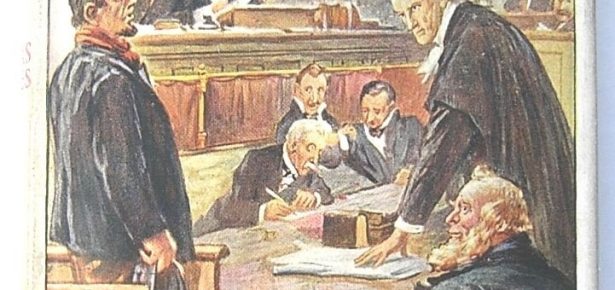
It is said that beauty is in the eye of the beholder. You could say the same about justice. In modern society, laws are written and codified, while justice is perceived and subjective. As often as not, when anyone besides a judge or legal practitioner talks about “the law,” what they are really interested in is their own idea of justice. And one person’s concept of justice can be very different from another’s. The biggest schism often lies between judges, whose priority is to uphold the law regardless of whether or not this is perceived as being just, and ordinary men and women, who typically have strong opinions on justice, but only a vague understanding of the legal system. Even those who work with law every day, however, might have serious disagreements over which laws apply in any given situation. Competing views of justice and the use of law most often collide in one particular locale, the courtroom.
The scholarly literature on law and justice is voluminous. Scholarship on the courtroom is sparse. When mentioned at all, the courtroom is usually a backdrop or afterthought to the more crucial dynamics of law, social relations and cultural encounters. At best, it is a stage on which legal performance or ritual is conducted. Concepts, practices, practitioners, complainants, defendants, witnesses and laws themselves pass through courtrooms, but are not changed by the experience. Those who study law, crime, and policing typically do not view courtrooms as generative locales. Law is everywhere in modern societies, scholars argue, forming the scaffold of civil society, but the courtroom is . . . just a room.
In popular culture, however, the opposite is true. Law is rarely mentioned beyond the word itself, while courtrooms are ubiquitous, from newspapers to television and film to novels and poetry. And in all of these instances, the courtroom is a site of triumph and tragedy, drama and comedy, the burlesque and the grotesque. Yet, for those of us who have spent any amount of time in a courtroom, the experience has been anything but entertaining. They are locales of staid bureaucracy, procedure, and steady deliberation. The wheels of justice turn but slowly, with little laughter and only quiet tears. Why this sharp contrast, I wondered, between the disregard for courtrooms in scholarship and their proliferation in culture, and between their typical operation according to dry protocol and their media portrayal as being captivating and sensational?
It was out of a desire to better understand how the modern courtroom developed as a unique and uniquely important space—legal, social, cultural, and physical—and how courtrooms rose to prominence in the daily life and culture of modern Britain, that I wrote Armed with Sword & Scales. In it, I introduce the concept of “courtroom culture,” how meaning is constructed, conveyed, and understood through the practices of the courtroom and their public representations. I focus on local courtrooms, known as “Magistrates Courts” or “Police Courts,” and several cohorts who were pivotal to their evolving roles. The result is an in-depth examination of the magistrates, municipal agents, working-class men and women, and other members of the community who frequented the London police courts from the early Victorian period until the First World War. Across that period, these courts rose to occupy a central position in the evolving relationship between the daily operation of law and its public depictions. The late Victorian and Edwardian years were crucial in both regards. The ascent of the London police courts was driven simultaneously by the expanding realm of activity regulated by law, courts’ key roles in adjudicating these laws, the increasing accessibility of local courtrooms to plebian men and women, and the proliferation of the courts’ public portrayals in the burgeoning popular press.
Sword & Scales asks many questions: what is the nature of the modern courtroom? How are ideas about justice generated and propagated? What is the relationship between a courtroom and the individuals who operate within it? Who wields the sword, and who can tip the scales? In sum, I have followed the ancient command, “justice, justice shalt thou always seek.” And that seeking has led me to the courtrooms of Victorian London. I hope that what I have found there will be of use to those who share my fascination with law and justice, and with the many ways and spaces in which both manifest. In offering the answers gleaned from a decade of research and writing, have I proved my case? That will be for you, the jury, to decide.
Latest Comments
Have your say!